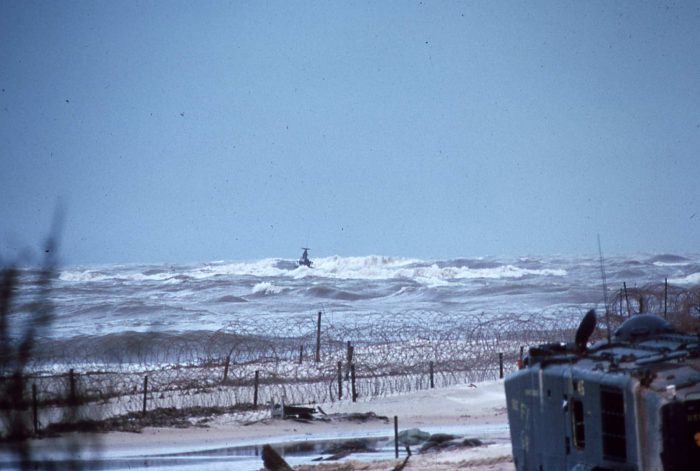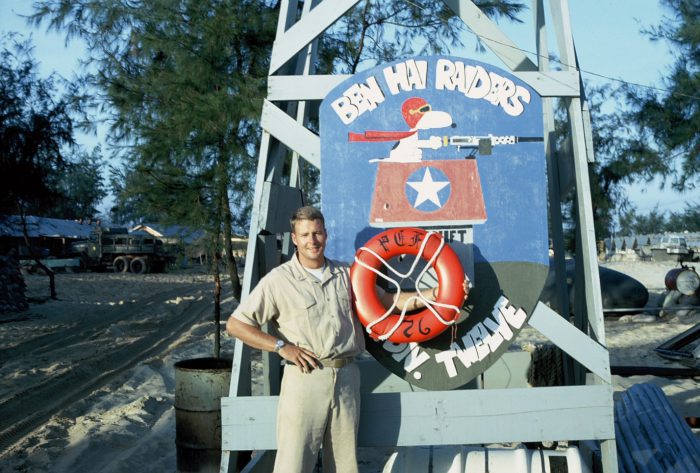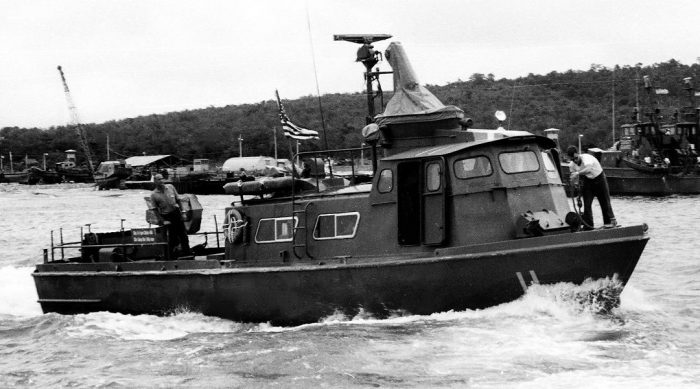50-Years Ago
November 1967
During the November northeast Monsoon storm season for the east coast of Vietnam, PCF’s 14 and 76 capsized and sank near the entrance of the Cua Viet channel which is just south of the DMZ border of South and North Vietnam.
Earlier in the year, a Swift Boat base had been established at Cua Viet which is just south of the DMZ that separated South Vietnam and North Vietnam. Previously Swift Boats would patrol this area from a base in DaNang, which was a 6 to 8 hour transit north to Cua Viet. This resulted in a short time for which the boats could be patrolling prior to returning to DaNang for fuel, supplies and rest.
The Cua Viet channel extends out about 5 miles from the river mouth. The channel has numerous sand bars and remains relatively shallow for those 5 miles. In shallow water, storm waves increase in height from their open ocean height. The outgoing river flow would combine with an outgoing ebb tide to flow towards the east against storm waves and winds coming from the east and moving west. These conditions created a treacherous condition where wave heights increased to more than 15 feet and the period between the waves was reduced to 10 to 6 seconds.
On November 6, the Cua Viet River, swollen with runoff and an ebb tide sluiced into a funnel at dramatic speed flowing against the incoming storm wave. The see if it was possible to navigate the channel and reach the ocean, PCF 76 conducted a weather probe.
 PCF 76 capsized in the channel. The skipper and one crewmember were rescued by helicopter while the rest of the crew was picked up by PCF 80 and its crew. Salvage efforts included dragging and a SONAR search, but contact with the boat could not be regained. All that was ever found was a wooden silverware drawer from the galley and an orange life ring with PCF 76 printed on it.
PCF 76 capsized in the channel. The skipper and one crewmember were rescued by helicopter while the rest of the crew was picked up by PCF 80 and its crew. Salvage efforts included dragging and a SONAR search, but contact with the boat could not be regained. All that was ever found was a wooden silverware drawer from the galley and an orange life ring with PCF 76 printed on it.

 On 30 November, while rescuing Vietnamese personnel from overturned sampans, PCF 14 capsized in the surf at the Cua Viet Channel entrance. PCF 55 took an 85 degree roll and had all but one man washed overboard during rescue operations for PCF 14. The one remaining man held on and PCF 55 as well as all of the PCF’s crew members and Vietnamese personnel were returned safely to port. The Swift Boat detachment at Cua Viet terminated operations on 30 November and all the boats were moved to the DaNang base.
On 30 November, while rescuing Vietnamese personnel from overturned sampans, PCF 14 capsized in the surf at the Cua Viet Channel entrance. PCF 55 took an 85 degree roll and had all but one man washed overboard during rescue operations for PCF 14. The one remaining man held on and PCF 55 as well as all of the PCF’s crew members and Vietnamese personnel were returned safely to port. The Swift Boat detachment at Cua Viet terminated operations on 30 November and all the boats were moved to the DaNang base.
Swift Boats were not the only craft to encounter heavy difficult seas. About 88 miles southwest of DaNang two 300-foot LST’s (Landing Ship Tank) broached in heavy seas.
Down south at the southern tip of Vietnam, sea conditions were not a problem.
On 3 November PCF 11 took an area approximately eleven miles north-northeast of Ca Mau Point under fire after receiving automatic-weapons fire from a bunker on the beach. Responding to corrections transmitted by an airborne spotter, The PCF destroyed a 100-foot long bunker line and initiated five secondary explosions.
On 5 November PCF 11 received automatic-weapons fire from the beach while attempting to close and inspect a sampan six miles northeast of Ca Mau Point. PCF 11 returned fire and utilized an airborne spotter to destroy one sampan, one structure and one bunker. There were five secondary explosions.
On 7 November PCF 11 provided naval gunfire support against a Viet Cong position 14 miles northeast of Ca Mau Point. Coastal Group 41 had received hostile fire from the area earlier.
 On 17 November PCF 54 conducted an H and I mission against two Viet Cong companies approximately 30 miles north-northeast of Ca Mau Point. The Swift Boat’s 81-mm mortar fire wounded at least seven of the enemy, destroyed four sampans and damaged three Viet Cong structures.
On 17 November PCF 54 conducted an H and I mission against two Viet Cong companies approximately 30 miles north-northeast of Ca Mau Point. The Swift Boat’s 81-mm mortar fire wounded at least seven of the enemy, destroyed four sampans and damaged three Viet Cong structures.
At the end of November there were 26,393 US Navy personnel in Vietnam.
51- Years Ago
November 1966
On 15 November 1966, while attempting to cross the bar and enter Hue harbor, PCF 22 lost one man overboard. PCF 77, also in the area, maneuvered to assist in rescue operations, broached and upended in the heavy seas, promptly sinking in 13 feet of water.
Helicopters in the area picked up seven people in the water, two of whom, Chief Machinery Repairman W. S. Baker, and Boatswain’s Mate Third Class Harry B. Brock, were dead. The man overboard from PCF 22 was picked up by his own craft. Radioman Third Class B. A. Timmons, who was believed to be below decks at the time the boat capsized, was not recovered, and was listed as missing, presumed dead.
At the time of the incident, PCF 77 was outside the surf line, standing by to assist PCF 22 as required. The skipper of PCF 77, LTJG David G. Wilbourne, had previously ordered all hands into lifejackets, and was at the helm. About 20 seconds after the man was reported safely aboard PCF 22, a wave, estimated to be 25 to 30 feet high, lifted the stern of PCF 77 and drove the bow into the trough. The Swift Boat flipped end over end. The pilot house almost immediately filled with water, although all doors and windows had been secured on the orders of the skipper. The survivors exited through the port pilot house door, which had sprung.
As the boat rapidly filled, LTJG Wilbourne was responsible for rescuing one man from the stricken craft, and Chief Baker, a qualified diver, was last seen entering the after compartment where Petty Officer Timmons was believed to be trapped. One and one-half minutes after upending, PCF 77 sank, keel up.
Security elements were provided by the Marine Corps, and the Salvagemaster of Harbor Clearance Unit One was dispatched to the scene. The bow section of PCF 77 was washed ashore 2,500 yards north of the Hue River mouth. The rest of the boat broke up, and HCU-1 Salvagemaster reported that a salvage attempt could not be affected.

Image enhance to illustrate a PCF in heavy seas

